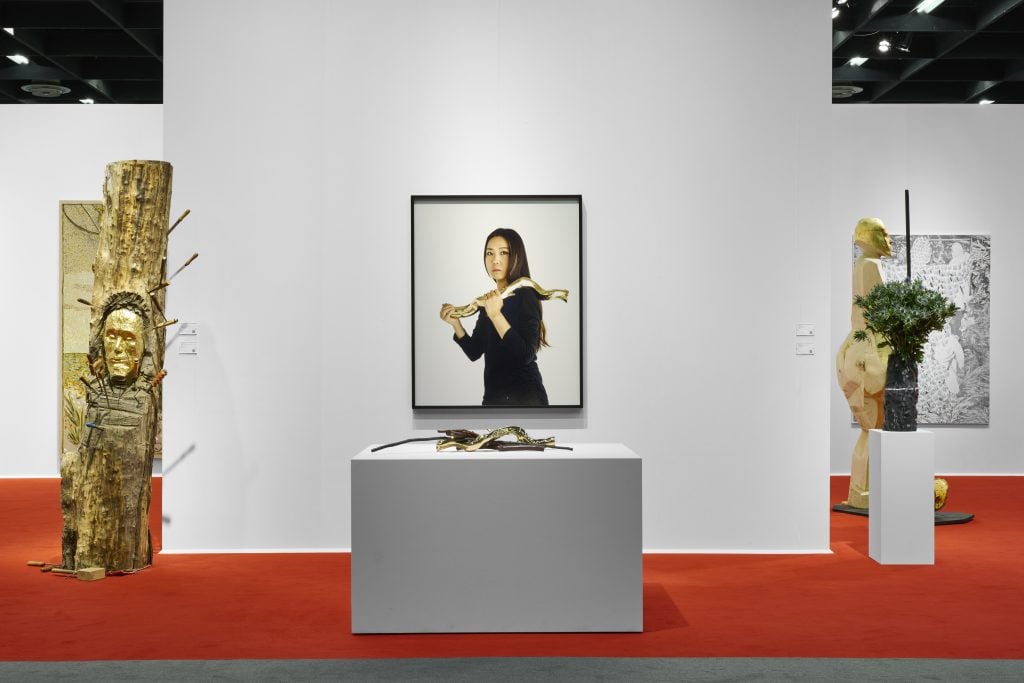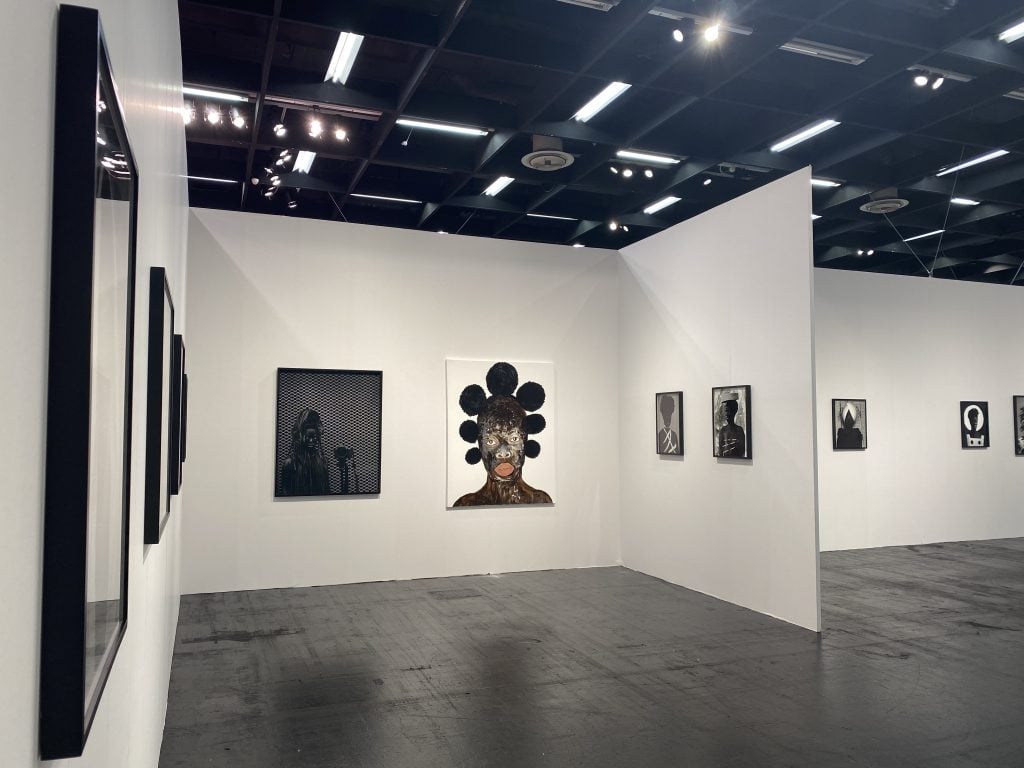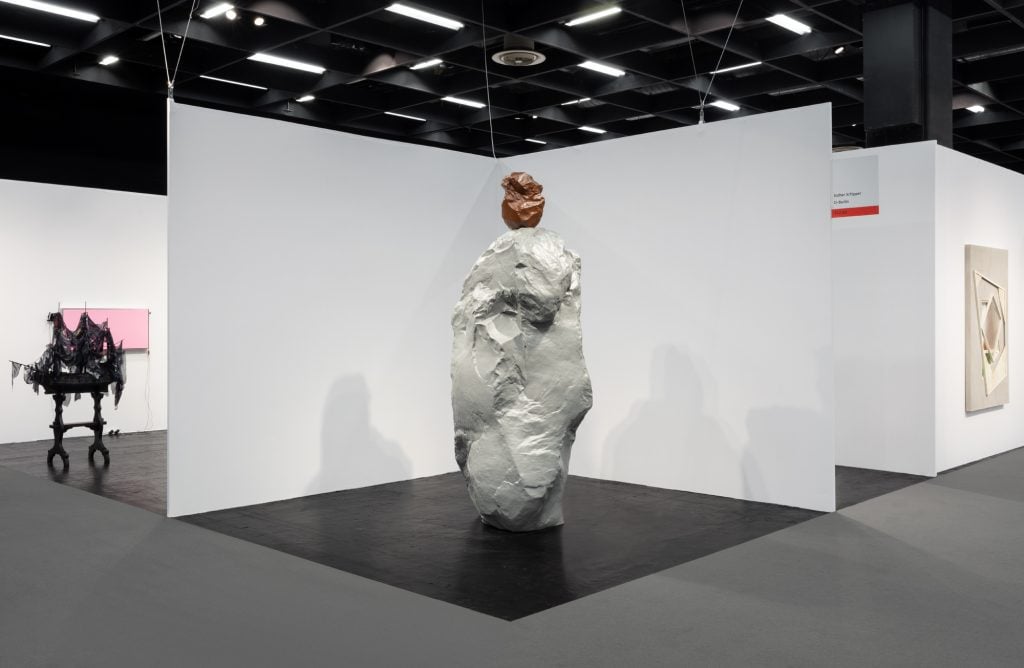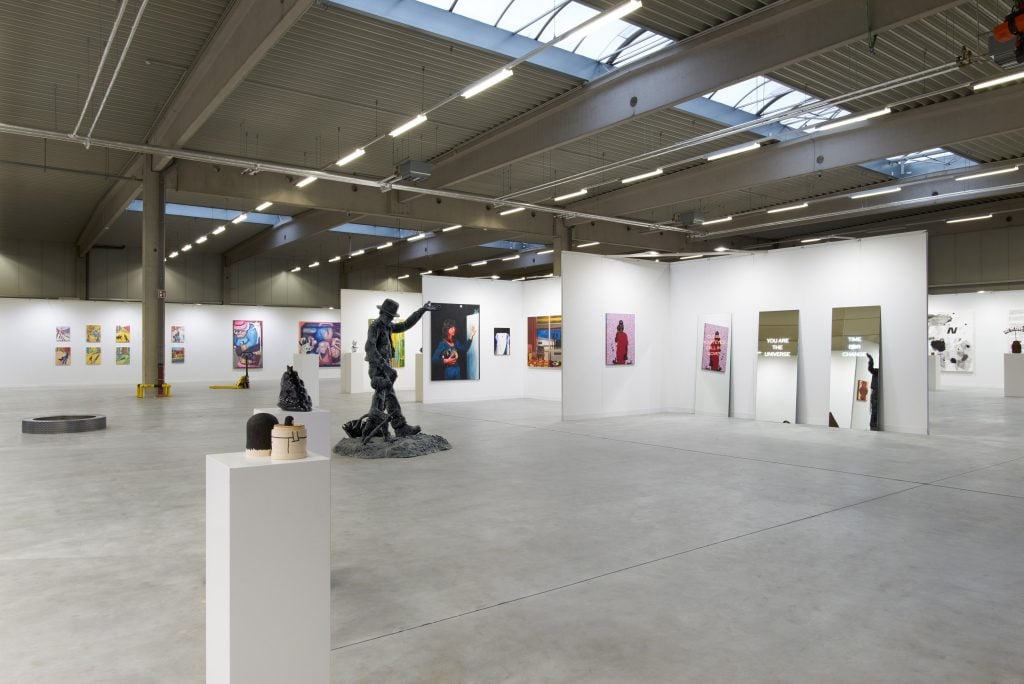Art Fairs
Despite the Threat of a Lockdown, Art Cologne Prevails With Steady Sales, Leaning on Its Strong Regional Loyalty
The fair opened this week with a congenial—if quieter—atmosphere.

The fair opened this week with a congenial—if quieter—atmosphere.

Kate Brown

Schmitz, an art-filled bar in Cologne, is a nightly stable for dealers, artists, and curators during a usual year of Art Cologne, which runs until Sunday, November 21. But it was notably quiet on the fair’s first VIP evening on November 17, and its dance floor was closed—leaving only a handful of people smoking upstairs in the backroom. But that is to be expected: it may be the opening days of the fair, but Germany is bracing itself for another potential lockdown, as a fourth wave of the coronavirus sweeps Europe.
Despite the whispered discussions about the benefit versus drawbacks of another lockdown, the art fair launched in a relatively convivial mood this week, after not one but three pandemic postponements. Certainly, the last-minute news that the fair would be offering a 35 percent discount to all 150 exhibitors helped ease some stress amid the surging caseloads.
And given that the backbone of the world’s oldest art fair has always been its strong regional profile, the local vibe of most of the masked visitors at this year’s edition surprised few. Dealers—and the fair organizers—would certainly welcome a more diverse clientele, but the the North Rhine-Westphalia region has no shortage of collectors with a deep understanding and love of art. It’s a more studied and discrete scene from what one might find elsewhere. “Someone will come off a tram with a backpack on and head into the fair and drop a bunch of money on art,” one dealer told Artnet News.

Works by Zanele Muholi at Pearl Lam Galleries at Art Cologne.
But another regularly seen cohort of collectors from the Benelux region (Belgium, the Netherlands, and Luxembourg), remained largely absent. The trio of wealthy countries are only a short drive away, but given the infection rate, which is hitting daily records, a trip to Germany and its steamy beer-houses for post-fair dinner parties, sloshing around bottomless glasses of kolsch, may not have its usual appeal.
Burkhard Riemschneider, the co-owner of Berlin’s neugerreimschneider, said one of the reasons the gallery, which represents artists Olafur Eliasson and Ai Weiwei, decided to participate in Art Cologne for the first time this year was because “the Rhineland has one of the most dense institutional backgrounds.” And the gallery brought a standout presentation—complete with a red carpet—centering on several tall wooden works by the Polish sculptor Pawel Althamer, including one burned to a dark charcoal, called Madame Notredame 2020.
The work in many of the booths tend to be skewed more towards German art, be it postwar or contemporary, which made a museum-quality display dedicated to South African photographer Zanele Muholi at Pearl Lam Galleries all the more striking. Such solo presentations are a dying breed in pandemic times, when dealers take fewer risks and more often opt for a mixed bag of art that give them a better chance to place something somewhere. But it seems to have paid off for Lam, which reported positively about sales so far.

A work by Ugo Rondinone at Esther Schipper’s booth at Art Cologne. Photo: Andrea Rossetti.
Long-time exhibitor Thaddaeus Ropac also had some success during the opening days, selling several pieces out of their hyper-clean booth, which was punctuated by a monumental work by Alex Katz in sea-foam green. The gallery placed three works with Cologne’s Museum Ludwig, and sold two works by Tony Cragg for €240,000 and €425,00 to private collections in France and the Rhineland, respectively.
Exile gallery from Vienna showed a group of paintings by Sine Hansen, a forgotten female darling of German conceptual Pop Art, who fell into relative obscurity in the 1980s and died, still under-recognized, in 2009. Presenting such mid-century painting in the contemporary section of the fair was an unusual move, but Hansen’s works from 1960s, with their hyper-pigmented colors and bulbous forms, rival many of the canvases from the 2020s on view elsewhere. The gallery brought several examples, ranging in price between €35,000 and €50,000. Not only is it hoping to place the pieces with a local institution, but founder Christian Siekmeier is also asking around some private collections to see if he can track down further works by the painter, since only about 15 are known to exist from the height of her career.

Cédric Eisenring Drei, Cologne. Courtesy of Drei, Cologne. Photo: Simon Vogel.
Johann König was spotted breezing through the fair aisles, headed in the direction of his booth, which features works by many of his roster artists, including the gallery’s newest addition, NFT-maker Refik Anadol. And while he manned the stand at Art Cologne, his offshoot fair company MISA installed their first event in the city in a large storage warehouse belonging to Cologne auction house Van Ham on the far outskirts of town. On offer are more works by the gallery’s artists, as well as some new positions, direct from artists’ studios, and pieces from Van Ham’s own collection.
Lena Winter, who used to work at auction house Ketterer Kunst before she was tapped to take over and expand König’s fair concept in 2020, is optimistic about the novel approach—and well-aware of the grumblings from some of their peers about it, too. “We are attacking an old system,” she told Artnet News. “If our project didn’t cause some controversy, we’d be doing something wrong.” The fair is planning to open pop-ups elsewhere in Europe and is considering events on other continents as well.

Installation view of Misa Van Ham Kunsthalle. Photo: © Saša Fuis Photographie, Cologne.
Other newcomers to Cologne include Sotheby’s, which marked its arrival in a city already packed with prestigious auction houses like Lempertz, Van Ham, and Ketterer by tapping into the art fair’s energy. Its sale “Contemporary Passions”, up through 26 November, includes works by German artists like Isa Genzken and Albert Oehlen from an unnamed Belgian art collection.
Back at the main fair, several dealers said they are expecting to close deals over the weekend, before they pack up and head home into what will likely be another winter of reduced contacts. Art Cologne 2022 will not be returning to its usual spring slot of April next year, but will remain in grey, rainy November. One can only hope that by then, we will see brighter days.
Art Cologne is at Koelnmesse through November 21.